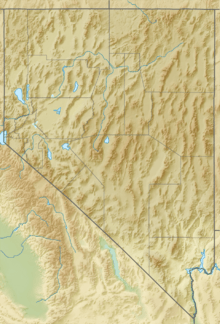Flowery Range facts for kids
Quick facts for kids Flowery Range |
|
|---|---|
| Highest point | |
| Elevation | 2,237 m (7,339 ft) |
| Geography | |
| Country | United States |
| State | Nevada |
| District | Storey County |
| Range coordinates | 39°23′32.689″N 119°31′20.633″W / 39.39241361°N 119.52239806°W |
| Topo map | USGS Chalk Hills |
The Flowery Range is a mountain range found in Storey County, Nevada. It is connected to the larger Virginia Range.
This mountain range is known for its beautiful wildflowers. These flowers bloom when snow melts, giving the range its special name.
Contents
Flowery Range: A Mountain of Wildflowers
The Flowery Range stands tall in the western part of Nevada. It is a part of the Basin and Range Province, a large area of North America with many mountains and valleys. This range might not be as famous as some others, but it has its own unique charm.
It is a place where nature thrives, especially after the winter snows melt. The melting snow provides much-needed water for the plants. This makes the range burst into color with many different kinds of wildflowers.
Where is the Flowery Range?
The Flowery Range is located in Storey County, Nevada. This county is in the western part of the state. The range is close to the city of Reno.
It is also near the historic mining town of Virginia City. The Flowery Range is considered a part of the Virginia Range. This means they are connected or very close to each other.
Why "Flowery"? The Story Behind the Name
The name "Flowery Range" is quite descriptive. It comes from the many wildflowers that grow there. These flowers appear especially vibrant in the spring and early summer.
This happens after the winter snows have melted. The water from the melting snow helps the flowers grow and bloom. Imagine a mountain covered in a carpet of colorful flowers! That's how the Flowery Range got its name. It's a beautiful sight that shows nature's power.
Plants and Animals of the Range
Even though the Flowery Range is in a dry state like Nevada, it supports a variety of life. The plants and animals here are adapted to the mountain environment. They can handle both cold winters and hot, dry summers.
The wildflowers are a big part of the range's ecosystem. They provide food and shelter for many small creatures. The range is a home for different types of wildlife.
What Plants Grow Here?
Besides the famous wildflowers, other plants grow in the Flowery Range. You might find different types of sagebrush. Sagebrush is a common plant in the Nevada desert. It has a strong, unique smell.
There are also various grasses and shrubs. These plants are tough. They can survive with little water. The wildflowers often include species like lupine, poppy, and desert paintbrush. These add bright colors to the landscape.
Who Lives in the Flowery Range?
The Flowery Range is home to many animals. You might see mule deer grazing on the slopes. Smaller mammals like rabbits, coyotes, and foxes also live here.
Birds are common too. Different types of hawks might soar overhead. Smaller birds find food and shelter in the bushes. Even reptiles like lizards and snakes make their homes among the rocks. These animals all play a part in the range's natural balance.
How Mountains Are Formed: A Look at Geology
Mountains like the Flowery Range are formed over millions of years. This process is called geology. The Earth's outer layer, called the crust, is broken into huge pieces. These pieces are called tectonic plates.
When these plates move, they can push against each other. This pushing can cause the land to fold and rise up. This is how mountain ranges are created. The Flowery Range is part of a larger geological area. This area is known for its "basin and range" structure. This means there are many parallel mountain ranges separated by flat valleys.


